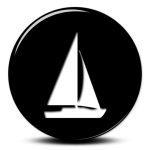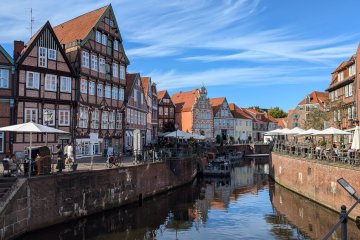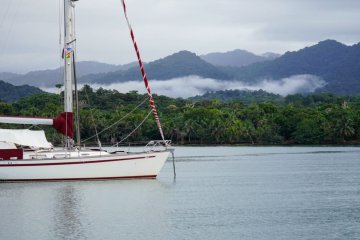For our 24-hour sailing trip from the Shelterbay Marina to the island archipelago of Bocas del Toro we had at the beginning a good wind with BF 5-6 and a wave height of 1,9m.
The boat was sailing well with 6 – 7 knots through the water, but only a disappointing 5 – 5.5 knots over the ground. This was due to a current pushing us backwards.
About 2100 we heard water under the floor in the galley (kitchen) area. Investigation revealed a considerable amount of water under the boards. We dealt with the water whilst thinking about where the water was coming from.
What was happening was that each time a wave washed over the the boat some water would come in from the pipe where the pump for the air conditioning should be – this had been removed for repair. Stupidly we hadn’t considered that the pipes from the pump eventually lead to the sea. Normally this would not be a problem but with no pump there, in came the water. It was a little hectic, but we were able to close one valve and fix the other quickly with a special foam cone made for this purpose.
At noon the next day we reached the Isla Colon, where our Belgian friends had already reserved a place for us in Bocas Marina.
The town of Bocas is very small, a little bit Wild West and very Caribbean.
The inhabitants are a mixture of Jamaicans and immigrants from the islands of San Andres and Barbados.
English is generally spoken, but also Spanish and the local language, Guariguari, which is a mixture of French, Spanish and other languages.
Many of the houses are all built over the water on poles and the many small islands can only be reached by the so-called “Pangas” (water taxi). Even from the small marina to the city you need a panga to get to the town.
The entire Bocas archipelago is a mangrove area.
In the city there are many colourful businesses, many small supermarkets, restaurants and of course many small food stalls.
The next morning we went to Bocas town and boarded a panga that took us to the mainland with an impressive speed. From there we boarded a bus which took us to the border of Costa Rica.
We had do this because our Panamanian Visa would expire after 90 days. We had decided to stay in Costa Rica in a town called Puerto Viejo for a week. This would mean we effectively left Panama and could re-enter and get a new Visa.
After about three hours through endless bananas and pineapple plantations we reached the river that marks the border between Panama and Costa Rica.
It is another border crossing straight from a spy movie. You have your passport stamped by the friendly guards, then walk up a few stairs past the tourist police (you get a small sticker from there) and then walk over a bridge (with all the locals and other tourists) into Costa Rica. On both sides a policeman glances at your passport, but that’s about it.
There we boarded another small bus that took us the remaining distance into the small backpacker town of Puerto Viejo.
Puerto Viejo is very touristic, but there is still a good mix between tourists and the very friendly locals. Everywhere Caribbean reggae music throbs from the many speakers.
During our 5 day visit we went on a bicycle trip to the nearest city and also cycled to the “Jaguar Rescue Center“. Here they keep injured animals and try to re-introduce them to the wild when they have recovered.
On one ride we spotted a sloth just hanging around in a tree at the side of the road. Many other people had seen it and there was quite a queue of cars, bikes and pedestrians looking and taking pictures.
We also did several other walks in the area.
For our return to Panama we were well prepared. We had a letter from the marina that our boat is there in Bocas and also booked a “fake” return airline ticket from Panama to Hamburg, because many South American countries require a return ticket on arrival.
Fingerprints were taken and some questions were asked, but then we got the desired entry stamp and Visa for another 90 days.
Back in Bocas Marina it rained the following days and was cloudy. Here it rains a lot more but the problem is the high humidity. This is not good for “Maya” because everything gets covered in white or black mold and needs to be constantly wiped with vinegar.
The marina here is a little run-down and already a little antiquated. Some sailors have been there for over 19 years!
Then we were visited by Heather, John’s sister, who landed here at the small mini airport with a small twin propeller driven aircraft. A very nice jump from the cold of the UK into the 34C tropical heat.
Here in Bocas marina and in the very small family run Marina Solarte there are many mosquitoes and the little biting flies (known as “No-see-ums”, correct name Chiquitas).
The next 3 weeks we spent in wonderful anchorages, all very well protected by the mangroves.
We visited the island of Bastimentos because of the wonderful beaches on the Atlantic side and the great hiking on the island – it was quite enchanting.
The island is known for the poisonous red frogs and we were lucky to find some on one of our exploration trips. They are really tiny little frogs, but they’re also extremely poisonous. The indigenous people used to use the poison for their arrows.
The small town of Old Bank in the south was also impressive with its Caribbean flair and the friendly locals.
An absolute highlight on the sailing back to the Shelterbay Marina was the visit to the Rio Chagres, which we did not want to miss.
The entrance was not easy because the river mouth is accompanied by several reefs on both sides. But once you get through the entrance, you enter a different world.
The Rio Chagres has fabulous original rain-forest on both sides with a biodiversity that seeks to be the same. An calming cicada concert and bird calls supported by the cries of the Howler monkeys. Here we stayed for 4 days and explored the entire Rio Chagres with the dinghy as well as the smaller, gorgeous tributaries. A really special place where we could observe the Howler monkeys in the morning and in the evening, as well as the many Green parrots and Toucans.
Back in Shelterbay Marina the next day we went to Panama City for 4 days. Staying in Panama’s Old Town, we explored the well restored town on the Pacific side. The first few side streets with the luxury hotels were top modern. But a few roads further, you can see the fallen houses and also the poverty that prevails here. That is the opposite that you see here. A super modern city on one side with many districts of misery on the other. There are 4 million people living here and life is very expensive, as our taxi driver told us.
Of course, a visit to the Canal Museum is a must.
Another highlight in March was the transit through the Panama Canal on the boat “Aspro” with our Belgian friends Ann & Thomas. They “hired” us as handliners and also a guy called Santiago, a professional handliner. With our two different advisers the transit became a really exciting experience.
After the first adviser came to us on the boat with a pilot boat, the afternoon was spent traversing the first three consecutive locks the so-called Gatun locks. In these locks we were tied together as a raft consisting of three boats, on the right of us a catamaran (German) and on the left a small boat (UK). We had a huge container ship in front of us.
Our handliner Santiago was first class. He skillfully caught all the lines with his hands. At the ends of the thin lines are so-called monkeyfists attached consisting of a heavy leather pouch so that the line is heavy enough to throw. In the first three locks you go further up the mountain and it is fascinating to see the height difference over 26 meters.
Arriving at the Gatun lake, the adviser took us to a buoy where we spent the night. Bob the Englishman asked if he could attach his boat to our boat. It turned out that John and Bob have a common friend, Andrew, in the UK.
He plans to cross the Pacific Ocean to New Zealand with his small Vancouver 27.
You wouldn’t believe it, but Bob celebrated his 83rd birthday the next day.
The next morning we motored across the Gatun Lake for 5 hours to the Pedro Miguel lock. From now on it goes down the Pedro Miguel lock and the two Miraflores again. First 9 meters deeper to Miguel Lake.
After the last section we passed under the “Bridge of the Americas”. Everyone was happy to have finally arrived in the Pacific. A really great experience.
After we had helped our friends safely in to the Marina Playita. The next afternoon we said our goodbyes and went by taxi back to the Atlantic side and Shelterbay marina.


